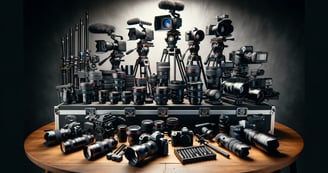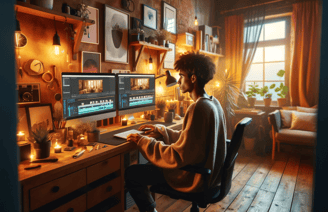
Understanding the Pricing of Videography Services: A Comprehensive Guide
This guide delves into the pricing of videography services, explaining factors like expertise, equipment costs, project complexity, and standard pricing models. It also highlights customizable pricing to provide insights into the value of professional videography.
VIDEOGRAPHY
11/9/202310 min read

Introduction
When it comes to understanding the pricing of videography services, there’s more to consider than meets the eye. Videography, an art and science of capturing moments and stories, involves a myriad of factors contributing to its cost. For businesses and individuals alike, comprehending these factors is crucial when seeking quality videography services. This guide delves deep into the nitty-gritty of videography pricing, unraveling the layers behind what you pay for and why.
At the core of these costs are years of expertise in both filming and editing, the sophisticated equipment used, and the unique skill sets that videographers bring to the table. But it's not just about paying for a service; it's about investing in an experience, a story, and an outcome that can significantly impact your brand or personal project. From the intricate planning stages to the final touches in post-production, every step in the videography process adds value and, consequently, factors into the overall cost.
Understanding videography pricing is akin to appreciating a fine craft. It’s about recognizing the blend of creativity, technical skill, and strategic execution that goes into producing compelling visual content. This guide aims to provide a clear, comprehensive view of the various elements that make up the cost of videography services, helping you make informed decisions for your next project. Let's embark on this enlightening journey to unveil the real worth behind every dollar spent on videography.
The Value of Experience and Expertise
The adage "you get what you pay for" holds particularly true in the world of videography. Behind every quote for videography services lies a wealth of experience and expertise. Professional videographers bring years, often decades, of experience in both filming and editing. This expertise isn't just about knowing how to operate a camera or edit a clip; it's about understanding how to tell a story visually, capture the right moments, and evoke the desired emotional response.
This experience extends beyond the act of filming. It encompasses pre-production planning, understanding the right angles, lighting, and audio for different scenarios, and post-production magic that turns raw footage into a polished final product. A seasoned videographer can navigate unexpected challenges, be it technical glitches or changing weather conditions, ensuring the project's success.
Moreover, expertise in video editing is a critical component of the videography process. Editing is where the story comes together – where the pacing, rhythm, and mood are fine-tuned. It requires not only technical proficiency in using advanced editing software but also a creative eye. The editor’s role is pivotal in transforming hours of footage into a coherent, captivating narrative.
In essence, when you invest in videography services, you're not just paying for someone to hold a camera. You're investing in a professional who brings a unique blend of technical skills, creative vision, and problem-solving abilities. This combination of attributes is crucial for creating videos that aren’t just visually appealing but also effective in conveying your message or story.
Investment in High-Quality Equipment
A significant portion of the cost of videography services is tied to the investment in high-quality equipment. Professional videography goes beyond just having a good camera; it involves an array of specialized gear designed to capture the best possible footage in various conditions. This includes top-of-the-line cameras, a variety of lenses to suit different shooting scenarios, action cameras, drones for aerial shots, as well as an assortment of filters.
But the investment doesn’t stop there. High-quality audio equipment is equally crucial to ensure that the final product has clear, crisp sound. Additionally, videographers invest in advanced lighting equipment to create the perfect ambiance for every shot, regardless of the natural light available.
The post-production phase also requires significant investment in software and hardware. Professional editing software, plugins, licensed music, and powerful computers capable of handling large video files and complex editing tasks are essential. These tools enable videographers to edit efficiently, add special effects, and ensure the final product meets professional standards.
Moreover, videography services often include other elements like professional voiceovers and copywriting, which require additional resources and expertise. Each of these components contributes to the overall cost of the service.
In summary, when you hire a videography service, you are not just paying for the time of the videographer but also for their substantial investment in specialized equipment and tools. This investment is crucial for producing high-quality video content that stands out in today’s competitive digital landscape.
Beyond Labor: The Full Scope of Videography Costs
Understanding the pricing of videography services requires looking beyond just the visible labor involved. A fitting analogy is the process of tree removal. When you pay $2,000 to have a tree removed, you're not just paying for the physical act of cutting down the tree. You're also paying for the expertise to do it safely, the equipment used, and the clean-up and disposal afterward. Similarly, in videography, the costs encompass far more than just the time spent filming.
The expertise of a videographer extends to their ability to plan and execute a project seamlessly. This includes pre-production work such as scouting locations, planning shots, and preparing schedules. These preliminary steps are crucial in ensuring the filming goes smoothly and are often invisible in the final product but essential to its success.
Equipment maintenance and upgrades are also a part of the costs. Professional videographers continually invest in their gear to keep up with the latest technology and ensure the highest quality output. This ongoing investment is vital in an industry where technological advancements can significantly impact the quality of the work.
Post-production is another critical phase where costs accrue. Editing is a labor-intensive process that requires attention to detail, a creative eye, and technical skill. It involves not just cutting and splicing footage but also color grading, adding effects, syncing audio, and much more. This phase can be time-consuming, and the expertise required is a significant factor in the overall cost of videography services.
Additionally, videographers often incur indirect costs such as insurance, software licenses, and continuous professional development. These aspects, though not directly visible in the final product, are essential components of professional videography services.
In conclusion, the cost of videography services is a reflection of the comprehensive scope of work involved in producing high-quality video content. From pre-production planning to post-production editing and the hidden costs of running a professional service, each aspect contributes to the final pricing. Understanding these elements helps in appreciating the value and investment behind professional videography services.
The Skillset: Filming and Editing Mastery
The skillsets developed in the field of videography are both valuable and challenging to master, contributing significantly to the cost of services. Proficiency in videography is not just about operating a camera; it's about understanding the nuances of visual storytelling. The skillset encompasses a wide range of capabilities, from capturing the perfect shot to meticulously editing footage to create a compelling narrative.
Filming requires a keen eye for composition, lighting, and movement. It's about capturing not just images but emotions and stories. Each project presents its own set of challenges, whether it's dealing with unpredictable lighting conditions, capturing fast-moving action, or creating a certain mood or atmosphere. A skilled videographer can navigate these challenges to produce high-quality footage that meets the project's objectives.
Editing is where the raw footage is transformed into a cohesive story. This process involves more than just cutting and arranging clips; it requires a deep understanding of pacing, rhythm, and storytelling. A skilled editor knows how to bring out the emotion of the footage, how to build tension or excitement, and how to engage the viewer from start to finish.
Additionally, the combination of creativity with marketing education is crucial, especially for businesses. Videographers need to understand not just the artistic aspects of their work but also how their videos can help achieve business goals. This might include driving sales, building brand awareness, or engaging with a specific target audience. The ability to align creative vision with business objectives adds another layer of complexity to the videographer's skillset.
In summary, the cost of videography services reflects the mastery of a complex set of skills. This expertise, developed over years of experience and continuous learning, is crucial in creating videos that are not only visually stunning but also effective in achieving the desired impact. The combination of technical proficiency, creative vision, and strategic thinking is what sets professional videographers apart and justifies the investment in their services.
Standard Pricing Structures in Videography
When navigating the world of videography services, you'll typically encounter three standard pricing structures: half day rate, full day rate, and hourly editing cost. Understanding these pricing models is key to appreciating the value offered and selecting the right package for your needs.
Half Day Rate: This rate generally covers 4-5 hours of filming and includes the use of all necessary equipment such as cameras, lenses, audio gear, lights, drones, tripods, dollies, and more. It also usually involves 1-2 personnel on set. This package is ideal for shorter projects or events that require professional coverage but don't need a full day's commitment.
Full Day Rate: This extends to 8+ hours of filming, encompassing all the equipment necessary for the shoot. Like the half day rate, it includes 1-2 people on set. The full day rate is suited for more extensive projects that require longer coverage, such as full-day events, detailed product shoots, or extensive location filming.
Hourly Editing Cost: Post-filming, the editing process is where the raw footage is turned into the final product. This phase is often charged at an hourly rate. The cost reflects the time and skill required to edit the footage, add effects, correct color, sync audio, and finalize the video to meet client specifications.
It's important to note that these rates typically do not include additional expenses such as rental fees for special equipment, extra crew if needed, travel expenses, and other potential costs.
Understanding these pricing structures helps in planning and budgeting for videography services. It provides transparency in what you're paying for and allows for a clearer comparison between different service providers. Each structure is designed to cater to different project scopes and requirements, ensuring there's a solution for a wide range of business budgets.
Customized Pricing for Diverse Business Needs
The notion that one size fits all does not apply to videography pricing, primarily because every project is unique with its own set of requirements and challenges. For instance, charging a flat rate for a 1-minute video overlooks the varying degrees of effort and resources needed for different projects. A 30-second to 1-minute video ad might require 3-4 full days of shooting to capture the perfect footage for a brand, while a 30-minute lecture video might only need 45 minutes of work. This variability is why videographers often avoid flat-rate pricing for all projects.
The complexity of a project dictates the time and resources needed. For a promotional video that includes interviews, b-roll, and requires no travel, a full day rate might be suitable to cover all the setup and filming. Then, estimating the editing time becomes crucial to provide a comprehensive quote.
Packages are more commonly found in services like wedding videography, where the event's nature is more predictable. For instance, a basic package might include one shooter for 6-8 hours and a 3-4 minute highlight film. More comprehensive packages could offer two shooters, extended filming hours, a longer highlight reel, wedding toasts, and drone footage. These packages are tailored to meet the typical needs of a wedding event, providing clear options for clients to choose from.
In business contexts, however, the requirements can vary significantly. From short social media clips to extensive corporate documentaries, the scope can differ greatly, necessitating a more customized approach to pricing. This flexibility ensures that businesses of all sizes and with varying budgetary constraints can find a videography solution that meets their needs without compromising on quality.
Ultimately, the goal is to provide a pricing structure that is fair and transparent, reflecting the time, effort, and resources required to bring a project to fruition. By offering customized pricing, videographers can cater to a diverse range of projects, ensuring each client receives a tailored service that aligns with their specific goals and budget.
Case Study: Videography Pricing for Weddings
To illustrate how videography pricing can be structured to suit specific events, consider the example of wedding videography. Weddings typically follow a predictable pattern, allowing videographers to create standardized packages that cater to common needs.
Basic Package: This might be priced at around $2,500 and could include one shooter for a duration of 6-8 hours, sufficient to cover the key moments of the day. The deliverable would usually be a 3-4 minute highlight film, capturing the essence of the wedding in a concise, beautifully edited format.
Premium Package: Priced higher, for example at $3,500, this package would offer more comprehensive coverage. It could include two shooters, ensuring that multiple angles and moments are captured, and extend to 8 hours of filming. The final product might be a 5-6 minute highlight film, along with additional features like coverage of the wedding toasts and drone footage to capture the venue and surroundings.
These packages reflect the standardized nature of wedding videography. They are designed based on the typical flow of a wedding - the ceremony, reception, and celebration. The structure and content of these events are generally consistent, making it feasible for videographers to offer preset packages.
However, it’s important to note that even within the realm of wedding videography, customization is possible. Some couples might want additional services like a full-length video of the ceremony or a next-day edit to share with guests. The key is flexibility and the ability to tailor packages to meet specific desires and expectations.
This case study exemplifies how package pricing can work effectively in scenarios where the service requirements are well-defined and relatively uniform. It demonstrates the videographer's understanding of the event's nature and their ability to package services in a way that aligns with common preferences, while still leaving room for personalization.
Conclusion
In conclusion, the pricing of videography services is a multifaceted subject, shaped by a variety of factors from the videographer’s expertise and the complexity of the project, to the cost of high-end equipment and the customization required to meet specific client needs. Understanding these factors is crucial for clients who seek to make informed decisions when hiring videography services.
The comprehensive nature of videography, encompassing pre-production planning, filming, and post-production editing, justifies the investment in professional services. Whether it’s capturing a wedding, creating a corporate ad, or filming a documentary, each project demands a unique combination of skills, time, and resources.
The standard pricing structures – half day rate, full day rate, and hourly editing cost – provide a baseline for understanding videography costs. However, the variability of projects necessitates a more nuanced approach to pricing, ensuring each client receives a tailored service that aligns with their specific goals and budget.










